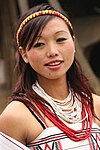Nyishi people
The Nyishi are geographically concentrated around the Dafla Hill range, located in the northern part of the Papum Pare district.Previously, they were referred to as Dafla, a term replaced by "Nyishi" through the Constitution (Scheduled Tribes) Order (Amendment) Act of 2008.The principal crops raised include paddy (rice), toppu (maize), mekung (cucumber), tak-yi (ginger), aeng (yams) and temi (millet), thumpe (pumpkin), perring (bean) and some leafy vegetables as their self-subsistence products.Nowadays It is being supplemented by beaks made of cane or other materials and the entire headgear/cane helmet itself is readily available in the market for purchase.Strings made of beads in varying sizes and colours are also worn, mainly for decoration purposes and to show the wearer's status.They also carry a machete or dao (uryu) in Nyishi) (short sword) and a knife (chighi) in a bamboo sheath that are mostly covered with animal furs.Their ornaments consist of a spear with an iron head, a large sword (uryu), and a bow and arrows which are tipped with poison (um-yu).The Nyishis, who traditionally wear cane helmets surmounted by the crest of a hornbill beak (known as pudum or padam), have considerably affected the population of this bird.Nature reserves, such as the Pakke Sanctuary, are being set up to protect the birds, while artificial materials, such as fiberglass, have been introduced as an alternative to the hornbill beak in Nyishi dress.

Naga woman
ISO 639 codeArunachal PradeshChristianHinduismDonyi-PoloMising peopleTagin peopleGalo peopleTibetan peoplenorth-easternNyishi languageSino-TibetanPolygynypatrilineallyNyishiKra DaadiKurung KumeyEast KamengWest KamengPapum PareKeyi PanyorLower SubansiriPakke KessangSonitpurNorth Lakhimpurcucumbergingermilletplaitedgreat Indian hornbillshort swordbamboogirdlegarterschignonhornbillWildlife Trust of IndiafiberglassTribes of Arunachal PradeshMishmiAka (Hruso)Apa TaniDigaro MishmiGalo/GallongHill MiriKhambaKhamtiKhamyangBugun (Khowa)Mikir (Karbi)MinyongMiju Mishmi (Kaman)MishingSherdukpenSingphoSulungTangsaWanchoZekhringChugpaLishipaHill tribes of Northeast IndiaMizoramChakmaDimasa (Kachari)HajongKhasi and JaintiaSynteng or PnarLyngngamKuki TribesMan (Tai speaking)Mizo (Lushai) tribesNaga tribesPawi (Lai)Synteng (Pnar)YimkhiungNagaNagalandBodo-KachariMeghalayaKhasi Synteng or PnarLakher (Mara)Abor (Galo)ApataniGalongKhowa (Bugun)Miju MishmiSingpho (Jingpo)Tai peoplesKhamptiMishing (Miri)PuroikManipurChotheGangteKoirao (Thangal)KoirengLamkangLiangmaiMaringMonsangRongmeiSuhte (Paite)TangkhulThadouVaipheiTripuraBhutiaJamatiaKhasiaLepchaLushai (Mizo)Munda, KaurNoatiaSantalTripuriSikkimSherpaTibetanHrangkhwal, RangkholKhelmaSairhemAngamiChakhesangKharamKhiamniunganKonyak